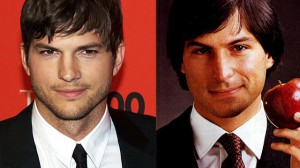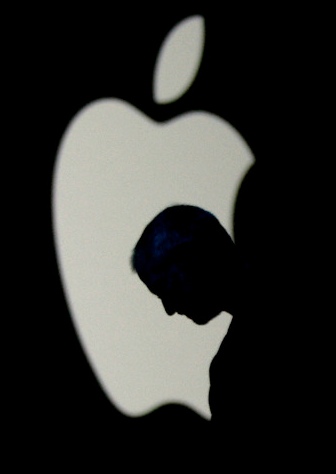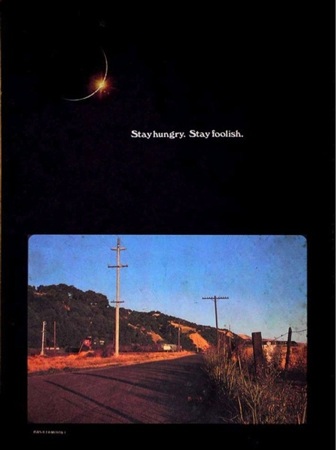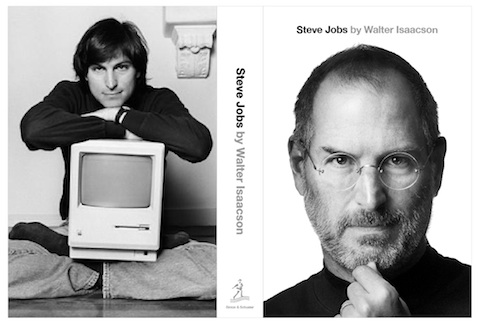Posts filed under 'Steve Jobs news'
Deconstructing pictures of JOBS

Now that I’ve covered most of my thoughts on the independent Steve Jobs biopic JOBS, whose premiere is today at Sundance Film Festival, it’s time to cover form i.e. production values.
Let’s review the official pictures that we’ve seen emerge from the film’s promotional campaign.
The first picture was that of Ashton Kutcher as Steve Jobs sitting on his desk:

Which was trying to reproduce the below picture from 1981:

Most people here would first see a striking resemblance between the two men. And I have to say, it’s really well done indeed. At a quick glance, they do look a lot alike, and it becomes obvious why Kutcher was picked to play the part of young Steve. But of course, being the obsessive-compulsive type with those pictures of Steve Jobs, I couldn’t help but notice a few things:
1. Physical build. The two men certainly have some things in common. But Kutcher’s build is very different from Jobs’s. Jobs was very wiry when he was young (in his hippie, fasting days especially), and in the mid-1980s, but he put on some weight at various points in his life. Not that he ate too much fat, of course; but probably more because he, like your fellow webmaster, was more into work than into sports. You can tell that in the picture above; and you can tell that Kutcher used to be a model, too. Basically, I wonder if Kutcher’s very athletic build will be credible as the impersonation of SJ on the big screen. Noah Wyle was better suited in that regard.
2. The watch. Look closely. In those days, Steve was a young millionaire, and showed off a little with his BMW motorcycle and his, yes, gold watch (after all, it was the 1980s). The watch that Kutcher wears is actually not bad, because SJ owned one very similar —only a few years later. So we’re dealing with a little anachronism here. Here is an example from 1984 that proves it:

3. The THINK poster. I would have been surprised if they had gotten that one right. But it’s the first thing that jumped to my eyes when I saw the picture of Kutcher. You see, that poster was not random. Its history was actually very well documented by Jef Raskin’s nephew —it is a variant of the Apple Syntax poster from 1980 (link from the Wayback machine). The original one featured Pascal syntax tips, and Steve Jobs was directly involved in its design. The version on his desk was using the same type as the Pascal header of the poster (3D letters with the Apple rainbow colors), applied to the IBM motto, THINK.
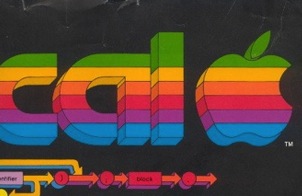
Unfortunately, the production crew of JOBS seemed to have bad eyes and to lack this information, as the type on their THINK poster seems to be dead flat.
My verdict:
Historical accuracy rating: 8/10
The second picture released by the JOBS team was one of the co-founders at the West Coast Computer Faire of April 1977:
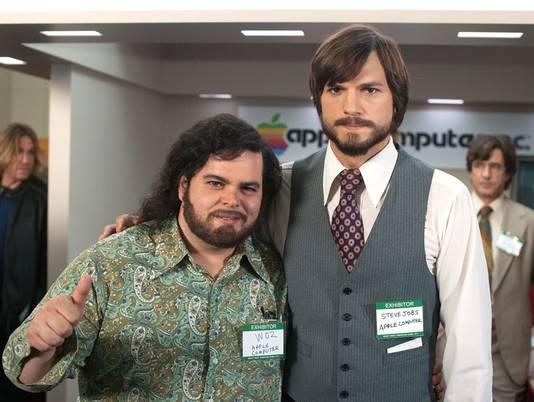
And, for context, two photos from the 1977 faire:

Steve Jobs was actually wearing his first suit that day, after the advice of Regis McKenna and Mike Markkula. I have very little to say here, the resemblance is striking and the costumes almost identical. (The same can’t be said of Woz though). Of course, I did find a couple things to complain about 🙂
1. The badge. A blowup of both pictures will get my point across:

You might think I am too harsh with the movie, but this is actually non trivial. The West Coast Computer Faire was actually Apple’s grand entry into the personal computing market, the first time they were ever considered seriously. And McKenna was instrumental in getting the young scruffy Steves to look like businessmen on that day. So having handwritten, diagonal names on their badges is actually far from the truth of what that show was. In addition, Jobs’s first name on the badge was “Steven”, not “Steve” (I’ll admit I’m picky with that one).
2. The booth. This is not about Steve, but the Apple booth, but again a small misconception on the importance of the West Coast Computer Faire for Apple. The movie makers couldn’t have guessed it from the black and white pictures (since they didn’t ask your fellow webmaster for advice) but that booth was actually lit by neon lights to look serious and attract visitors. Markkula put up heavy money for this, for a startup. Check this out:
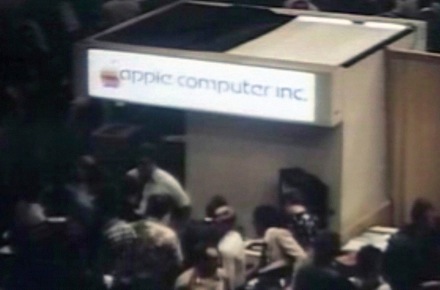
3. The hair. Steve’s was a lot dirtier 😉
Historical accuracy rating: 9/10
I’d be interested to know what you guys think of this. I must say I was a little disappointed. With the great production values and all this talk of a ‘wow’ performance from Kutcher, I was actually expecting something close to the reality of Steve’s youth. That’s not what I saw in this clip.
Where do I start?
- the weird, forced intonations. “That changes e-ve-ry-th-in'”. Steve spoke fast, especially in those days. And he certainly didn’t speak to Woz the way he did keynotes in the 2000s;
- the depiction of Wozniak as basically a corporate stooge, in a suit, saying “Hi Charlene” to a colleague. He did like the comfort of a salary from working at HP, but I don’t think anyone could say Woz was the corporate type;
- the exchange on “the operating system” as if the term was new and coined by Wozniak. Yes, seeing what you typed on a keyboard on a TV screen was extraordinary. But this had nothing to do with the expression “operating system” which had been around for a good ten years then. As an example, Gary Kildall’s popular CP/M had been developed in 1973, three years before the Apple I…
- “nobody wants to buy a computer”… coming from Woz? It’s true that the idea of selling was stranger to him. But certainly not the idea of personal computing, since he was so familiar with it after attending the Homebrew meetings, where it was pioneered.
Woz actually confirmed what I felt in writing to several blogs, starting with Gizmodo, I quote:
Totally wrong. Personalities and where the ideas of computers affecting society did not come from Jobs. They inspired me and were widely spoken at the Homebrew Computer Club. Steve came back from Oregon and came to a club meeting and didn’t start talking about this great social impact. His idea was to make a $20 PC board and sell it for $40 to help people at the club build the computer I’d given away. Steve came from selling surplus parts at HalTed he always saw a way to make a quick buck off my designs (this was the 5th time).
The lofty talk came much further down the line.
I never looked like a professional. We were both kids. Our relationship was so different than what was portrayed. I’m embarrassed but if the movie is fun and entertaining, all the better.
As he says:
It’s only one clip. The movie should be very popular and I hope it’s entertaining. It may be very correct, as well. This is only one clip. But you’ll see the direction they are slanting the movie in, just by the dialog style of this script.
I hope he’s right.
Historical accuracy rating: 4/10
Kutcher has a date and Sorkin has a pitch
As promised, here is my take on the news about the two upcoming Steve Jobs movies. For those suffering from chronic memory loss, these movies are:
- JOBS (ex-jOBS, a.k.a. “the Kutcher picture”), an independent movie directed by Joshua Stern starring Ashton Kutcher
- and “the Sorkin movie”, my codename for a Sony Pictures Entertainment project using the rights for Walter Isaacson’s Steve Jobs (bought for $1 million), whose script will be written by Aaron Sorkin (scriptwriter of The Social Network)
Narrative
The most obvious and perhaps most interesting difference between these two movies is their timeframe. Indeed, JOBS will focus mainly on Steve Jobs’s youth, from 1971 (age 16, in high school, when he was friends with Woz) to the comeback at Apple (or even later… 2000? when he became Apple’s CEO?)

Kutcher as Jobs
For those of you have seen the only fiction movie about Steve Jobs yet, Pirates of Silicon Valley starring Noah Wyle as Steve Jobs, the choice of period is very similar. Pirates starts in the Berkeley riots of the late 1960s, to show the friendship between Steve and Woz, and ends at the Macworld Boston keynote in July 1997 (the famous “Gates as Big Brother” keynote). But the bulk of the action happens in the early 1980s, during the development of Macintosh, and there is no mention of NeXT or Pixar (the years 1985 to 1996 are actually not showed at all). Pirates is different though, as Bill Gates is as important a character as Steve Jobs in that TV movie.
As a result, the narrative in Pirates is alternating between telling the stories of both characters, and Steve only gets half the spotlight, with short but symbolic scenes such as the West Coast Computer Faire, Apple’s IPO, his relationship with Chris-Ann and Lisa, celebrations and arguments with the Mac team, or his 30th birthday. The TV movie was actually successful portraying a dramatized but fairly accurate picture of the two fathers of modern personal computing, and SJ himself acknowledged it by inviting Noah Wyle disguised as his modern self to introduce the Macworld NY 1999 keynote.

Noah Wyle as Steve Jobs in Pirates of Silicon Valley
It’s an open question whether JOBS can pull off such an accomplishment. Since we know the movie is at least showing Jobs in India (age 19) and in 1997 (age 42), the question is, what in these 25+ years will be showed, and what will be forgotten? I hope it won’t be as bad as the Isaacson bio, which managed to dedicate one whole chapter on the week of the departure from Apple, and one other chapter for the whole decade at NeXT… But I have my doubts on the portrayal of the NeXT and Pixar ventures. NeXT is crucial in Steve’s history, as it was, after all, the first time he was truly the man in charge, and its failure was the basis for the resurrection of Apple. As for Pixar, of course, there wouldn’t have been a return to Apple without the media attention and riches that the animation studio brought to Steve.
I am not implying that giving a compelling yet accurate picture of a life so eventful is easy. I have myself agonized (and still am) over the writing of Steve’s biography, which simultaneously follows different threads: the Lisa drama at the time of the IPO, the struggles with NeXT and with Pixar concurrent to the discovery of Mona and the wedding with Laurene, etc. To do all this in a 120-minute format is next to impossible, and something’s gotta give. I hope that JOBS doesn’t let go of the main drive of Steve’s life, his passion for technology. I wonder, for example, how the trip to Xerox PARC will be depicted (if at all). Same with the NeXT Cube introduction. This is one area where Pirates of Silicon Valley was actually not bad.
For the Sony movie, the answer to the question “what will be ignored” is actually quite simple: “almost everything”.
Indeed, as I said in the intro, Sorkin’s intention is to have the movie play out in real time (meaning every minute on the screen is a minute in the movie), with no flashbacks or cuts of any sort. Three times thirty minutes, the thirty minutes that precede Jobs’s entry on stage for three key product introductions in his career: that of the Macintosh, the NeXT Cube, and the iPod.
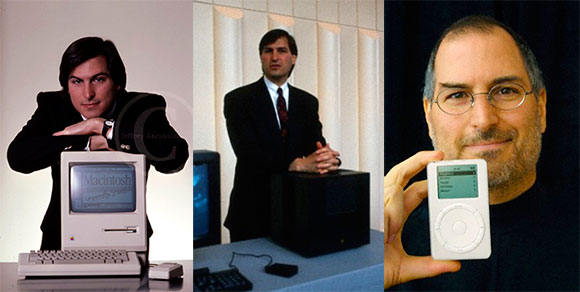
1984, 1988 and 2001 – the three pillars of Aaron Sorkin’s scripts
First of all, what was the point of buying the rights of Isaacson’s bio to write such a script? All the facts there are to know are in the recordings of those events (including that of the NeXT Cube intro, which I have been longing for for the past five years now). The rest can only be in allusions or short appearances of characters, and will not be from the bio for sure. Actually it is obvious already what will not be in such a movie: anything having to do with Jobs’s family (Lisa, Mona, Laurene, Reed, Erin or Eve); or even, anything Pixar? I don’t see how they could fit in the narrative as Sorkin describes it. And how could the complexities of the character be reflected in such small segments? I just watched Scorsese’s The Aviator again to get some perspective —imagine if the whole movie had been reduced down to just the premiere of Hell’s Angels, the plane crash, and the Congressional trial, for instance; how would that give a rich description of Howard Hugues? Needless to say, I am skeptical.
Yes, it is hard to do a full-blown biopic, and if Sorkin listened to me, he would have to do a Lord-of-the-Rings-type trilogy, even a tetralogy (1955-85; 1985-1996; 1997-2007; 2007-2011 would probably be a nice breakdown). I am (and you are, if you’ve read this far) probably one of the few people on this planet who would bear to sit for 14 hours to re-live the life of Steve Jobs on the big screen. But I understand that Hollywood is an industry and that such an endeavour would not make much business sense. The problem is that I’m not sure Sorkin’s approach makes much sense, either.
Let’s give the man credit and suppose that he pulls this off. After all, he does have a good track record. So suppose his three-scenes-before-keynotes approach works well —still, I can’t get around his choices for those three keynotes. The idea, I assume, is to give snapshots of Steve’s personalities at very different moments of his life. The plot could be organized around such lines: first, the arrogant young millionaire at the peak of his early success; then, a fallen-angel type of deal with NeXT, the thirty-something entrepreneur back with a vengeance (and perhaps a healthy dose of moving scenes relating to Lisa or Mona); and finally the 45-year-old ready to take over the world.
To start with, it is bold to begin the movie in 1984. I personally like the idea to ignore the oft-told tale of the hippie days at Reed or in India, and the garage days of Apple. But to start with the Macintosh launch means probably skipping over the rough early 1980s, and how they transfigured young Jobs, with the intense learning of business, the riches and the fame from the IPO, the inner conflicts with Lisa (the girl) and Chrisann, the Eureka moment at Xerox PARC, and the fanatical days of the development of Macintosh after the failure of Lisa (the computer).
The jump from 1984 to 1988 makes more sense — some might say it’s just four years, which can be summed up with the crisis and departure of Apple, and the development of NeXT… oh, yes, there’s also that side project, a little startup called Pixar (don’t count on that one). Yet in these four years, Steve changed a lot, and I have to give credit to Sorkin for dedicating a third of his script to a crucial turnaround point in Steve’s life, which is all too often plain forgotten. I’m actually quite excited to see how NeXT could be presented in that segment. Will it be all about “revenge”? Yes, revenge was part of NeXT, but the ambition of the Cube was so much more. In a lot of ways, Steve of 1988 was a prototype to Steve of Apple 2.0. I wonder if Sorkin gets that.
Much more radical is the switch from 1988 straight to 2001. How will that account for the ten years of struggle at NeXT and Pixar? The new family life? The late triumph of Pixar? The comeback and subsequent coup at Apple? Again, I suspect NeXT and Pixar will be left in the background, and that Sorkin will try to drop hints at the future of Apple instead… that’s why the choice of the iPod keynote left me dumbfounded. Like I suspect many others, I would have bet a fiver on the iPhone introduction instead. Not only because the iPhone was perhaps Steve Jobs’s greatest masterpiece, and its introduction blew the whole world away. But also because he was actually conscious of that, and made that keynote as dramatic as can be. Everyone who watched it remembers how he started the iPhone section of his presentation by telling he couldn’t sleep the night before, because he knew that Apple was about to make history once again.
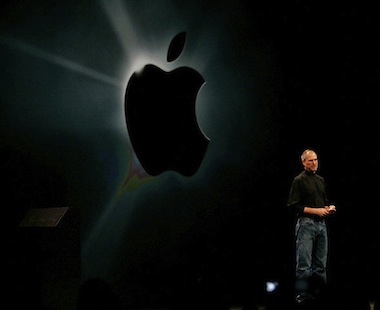
Not so for the iPod. Far from it. For those that doubt it, just watch the keynote again. I wouldn’t say it’s dull or boring, because the product was damn exciting — but you could tell neither Jobs nor the audience (mostly press and Apple employees) expected it to be da bomb that it turned out to be. And as a result, the iCEO wasn’t nearly as charismatic as he was at Macworld 2007. The scale of the keynote certainly played its part too, it was only in the small auditorium of Cupertino vs. the huge hall of Moscone West.
I don’t think that Sorkin will reflect that lack of showmanship and excitement in his movie. In fact, I expect him to put a lot in that segment that shouldn’t, that couldn’t have happened in 2001. I actually think this is what the success of his script boils down to: the sum of the choices he will have to make, because of the format he’s chosen. There’s a very high bar for him to make good ones. My hat’s off to him if he manages to give birth to a masterpiece within these self-imposed constraints.
A paradox
The two Jobs movies were not born under the same star.
One was conceived in 2011, after Steve’s resignation but before his passing. It is an independent movie whose creators come mostly from TV and have no track record with feature-length films, including its lead star, Ashton Kutcher, who started out as a model. It will premiere at the Sundance Film Festival, the first choice for most independent features. The other is based on Walter Isaacson’s authorized biography. The book was written with Jobs’s full cooperation, but it was rushed to market after his death, to successfully become one of the best selling books of the year. Very soon afterwards, the rights were sold to major studio Sony Pictures for a couple million dollars. One of Hollywood’s most highly-regarded writers was put in charge of drafting its scripts. It will certainly be introduced with a huge media campaign à la Hollywood.
Here comes a paradox.
On the one hand, history suggests that movies in the hands of major studios tend to feature high-profile movie starts, be overkill in production values, and unimaginative with their narrative. On the other hand, independent cinema tries to compensate its lack of visual debauch and its usually obscure cast (due to scarce funds) by being more audacious with its subject matters and plots.
This is not what we’re starting to see here. The independent movie has a movie star in its own right. And from the first images we’ve seen, the production values seem to be impeccable. The costumes and sets are almost perfect reproductions of the 1980s and the early days of Apple. Kutcher was even cast probably for the reason that he looks so much like young Steve Jobs! But his talent at impersonating our hero will have to be tested. I have honestly never watched anything from his filmography, and in fact, I had never heard of him before he was picked for JOBS. So I can’t judge him before I see the movie. However, I can’t help but hear a lot of bad rap, especially along the lines of “almost anything can be played by actors —except intelligence”. I will give Kutcher the benefit of the doubt, but this is definitely the fear: perfect form, and no substance, a movie that looks like a documentary but misses the essence of its main character. I hope this isn’t the way JOBS will go down into history.
The Sony movie is also breaking clichés on cinema. We’ll have to see if Sorkin’s plan is followed through by the studio, but if so, needless to say that the narrative of the movie will be quite unconventional. That’s right —a lot less conventional than its independent counterpart! It will be the big production that takes the most risk. I still have my doubts as to what Sorkin can make of the Steve Jobs story. Will he —can he— get it? Again, the final word will come when both movies are out. But the outcome might be quite unlike what one could have expected!
Needless to say, I am quite excited by the prospect of watching and reviewing those two movies. Please, dear moviemakers, hurry up!
Steve Jobs’s yacht, Venus, now launched
“There’s no yacht in my future,” Steve Jobs declared to NY Times journalist John Markoff in November 1995, to illustrate his goal in life was not to make money. Had he not died last year, this phrase would be filed among the many contradictory statements Jobs made throughout his life —because two weeks ago, the yacht he spent the last years of his life designing finally launched. I just added a dedicated page about this boat under Steve’s Places (where it best fits, with the private jet).
We first heard about the Jobs yacht last year, when the Isaacson biography was published. It remained a mystery to me since then, especially because of my particular interest in ship design (albeit bigger ones) —but I somehow didn’t expect it to ever be revealed. I thought it would remain in the private sphere of the Jobs family, if it was finished at all. But the resolve of Laurene Powell-Jobs and the voyeurism of today’s media got the better of me, as the yacht (Hull #684) was launched very publicly on October 28 2012. The Feadship shipyard, where the boat was built, even released a note about it on their website (without mentioning the owner’s identity, though; but the rows of iMacs in the bridge leave little doubt about that).

The press release on Feadship’s website
The Venus —as she is named, after the Roman goddess born from the foam of Uranus’s genitals dropped into the sea (Wikipedia confirms)— is indeed very Jobsian in her aesthetics. The very clear-cut lines of her hull, the minimalist superstructure with its right angles and floor to ceiling windows, the lack of any visible mooring or radio equipment… all make for a surprising design that evokes more a floating modernist house than your typical billionaire yacht. Compare and contrast, for example, with Larry Ellison’s latest yacht, Musashi, which is way more traditional —and whose design Jobs supposedly hated (according to Isaacson) which inspired him to create his own, perfect ship.

The Jobses on a cruise in the Corinth Canal, circa 2006
Isaacson writes:
Before his liver transplant, he and his family used to rent a boat for vacations, traveling to Mexico, the South Pacific, or the Mediterranean. On many of these cruises, Jobs got bored or began to hate the design of the boat, so they would cut the trip short and fly to Kona Village. But sometimes the cruise worked well. “The best vacation I’ve ever been on was when we went down the coast of Italy, then to Athens—which is a pit, but the Parthenon is mind-blowing—and then to Ephesus in Turkey, where they have these ancient public lavatories in marble with a place in the middle for musicians to serenade.” […]
After the joy of that cruise, Jobs had amused himself by beginning to design, and then repeatedly redesigning, a boat he said he wanted to build someday. When he got sick again in 2009, he almost canceled the project. “I didn’t think I would be alive when it got done,” he recalled. “But that made me so sad, and I decided that working on the design was fun to do, and maybe I have a shot at being alive when it’s done. If I stop work on the boat and then I make it alive for another two years, I would be really pissed. So I’ve kept going.”
After our omelets at the café, we went back to his house and he showed me all of the models and architectural drawings. As expected, the planned yacht was sleek and minimalist. The teak decks were perfectly flat and unblemished by any accoutrements. As at an Apple store, the cabin windows were large panes, almost floor to ceiling, and the main living area was designed to have walls of glass that were forty feet long and ten feet high. He had gotten the chief engineer of the Apple stores to design a special glass that was able to provide structural support.
By then the boat was under construction by the Dutch custom yacht builders Feadship, but Jobs was still fiddling with the design. “I know that it’s possible I will die and leave Laurene with a half-built boat,” he said. “But I have to keep going on it. If I don’t, it’s an admission that I’m about to die.”
The scenes described by Isaacson lets my imagination run wild. Can you imagine being shown models and drawings of the yacht of Steve Jobs’s dreams… by the man himself? It reminds me of the famed models of a hypothetical modern house for Woodside, dating back from the late 1980s, but which never materialized. It seems that the prospect of a nearing death must have pushed the Apple CEO to stop refining (some would say procrastinating) and actually turn his plans into reality. I find it interesting that he chose to spend the limited time he had on the yacht (and the Apple Spaceship) rather than his family home. Perhaps it is because of the greater liberty and challenge that is peculiar to naval architecture; a ship is its own universe, it must be self-sufficient when on water. Not so with a house. Or perhaps it was only because he could see the Woodside teardown taking too long to happen, who knows.
This first, exciting yet mysterious reveal was in October 2011, just two weeks after Steve’s passing. But another one came some six months later, when my fellow countryman designer Philippe Starck announced in a radio interview he was working on a “revolutionary” project with Apple that would come out “in eight months”. I assumed he was drunk or suicidal —the former option was probably the most likely, because after Apple denied his claims, he admitted he was in fact working on a personal project with the Jobs family: “I’ve come to visit him once a month for seven years in Palo Alto, and I’m actually going there next Monday, because now that he’s dead, I’m working with his wife. We enjoyed exchanging about interesting things” (translated from the French by yours truly).
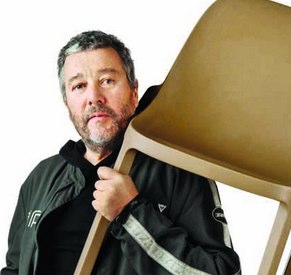
French designer Philippe Starck who partook in the Venus design
The anecdote aside, I thought it was another Jobsian move to use the services of Starck. This is because I’ve come to believe the theory laid out by Alan Deutschman in The Second Coming of Steve Jobs, according to which Jobs was insecure about his taste in his personal life (not so much in his work, obviously) and liked to take advice from renown taste makers to shape his own. It’s possible he couldn’t decide when you know he spent the better part of his youth living in empty houses. And it’s also true that he used world-famous architect I. M. Pei’s services to design not only the staircase of the NeXT offices, but also the remodeling of his Manhattan apartment (not that he ever lived there) and supposedly some early projects for Woodside, too. That he would call on Starck for the design of his yacht fits well within this trend.
The last Jobsian touch was actually from the Jobs family —maybe Steve had planned, or maybe Laurene did something she thought he would have done. They sent a thank you note to all the workers of the Feadship yard stating “Thank you for your hard work and craftsmanship – from the Jobs family” with a stylized silhouette of the Venus at the bottom. (The note came with an iPod shuffle which, to be honest, did remind me of one of the earliest Fake Steve Jobs pieces…)
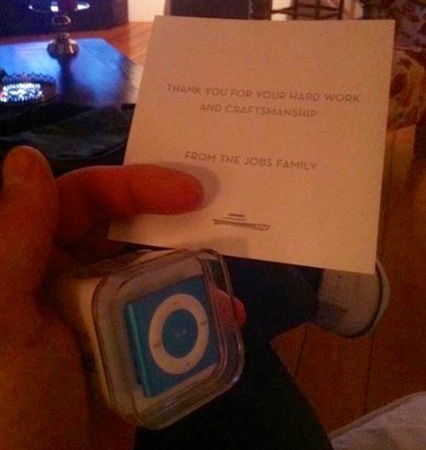
And so it is one year after her reveal, and apparently eight years since her inception, that the Venus starts sailing the seven seas. I really wonder what she will be used for. Will the Jobses actually use it and sail across the globe? Or did Laurene insist on finishing one his husband’s late projects? This might stay secret as it is part of the Jobses private life. But my appetite for more details is really not about that. Indeed, many more questions have sprung in my mind from these first photos of the yacht: what is it like inside? Where and how is the equipment hidden? How does the superstructure hold? How are the navigation computer systems designed? What’s the engine room look like? (I imagine it’s neat knowing Steve’s love for machines)… The mystery of Steve Jobs goes on.
Remembering Steve
To mark the one-year anniversary of Steve Jobs’s passing, Apple posted the following tribute on the homepage of their website on October 5, 2012:
It is still up at the time of this writing. I suspect it will stay here for a week. For future visitors of the site, I have republished the video in the new Misc Movies & Recordings section.
The images that can be seen in the video are, in order of appearance:
- Steve Jobs in his home with Macintosh, 1984 (by Norman Seeff)
- with MacBook Air, Macworld 2008
- with the original iMac, 1998
- with the first iPod, 2001
- with iPhone, Macworld 2007
- again, at Macworld 2007 doing the joke with the Starbucks employee on a call
- laughing at his desk, 1984 (by Norman Seeff)
- at the opening of the New York 5th Avenue Apple retail store, May 2006
- outside the 5th Avenue retail store, same day
- working on the Apple I, 1976 (by Joe Molena)
- at home in summer 2004, by Diana Walker
As far as Steve’s voice is concerned, the extracts come from:
- Macworld 2007, 9 January 2007
- original iMac introduction, 6 May 1998
- iPod introduction, 23 October 2001
- Macworld 2007 again (for both the introduction and the phone prank)
- iPad 2 introduction, Steve’s second-to-last keynote, 2 March 2011
All these keynotes can be seen in the Steve Jobs Keynotes section of the site.
The soundtrack is Yo-Yo Ma’s interpretation of Bach’s Cello Suite No. 1, which I suspected on Twitter. Macstories has a nice story on how they are sure of it, because Yo-Yo “plays the first four Bach suites tuning down his cello a full semitone” to be closer to how the music sounded back in the 17th century.
I found the video to be very well made, and frankly, quite moving. Tim Cook’s letter, who picked his words just as carefully and with the same talent as Steve himself used to do on such occasions, were also very appropriate.

The Steve Jobs movies
Because I have been very busy with my studies in the past months, I haven’t been able to write a proper lowdown about the two Steve Jobs biopics that are currently being prepared for release in the coming months. Yes, for those of you who haven’t paid close attention to the news, there are really two Steve Jobs movies in the works.
1. jOBS: Get Inspired (official site)
The first project that was started is more commonly known as “the Kutcher movie” because the part of Steve Jobs will be played by Ashton Kutcher, as we learned in April. Being a Parisian snob, I had no idea who that Kutcher character was so I looked him up. Apparently he owes more his fame to his good looks than his acting skills. He is a former model and was Demi Moore’s husband for (only) six years. From his filmography I have only seen The Butterfly Effect (if you omit Robot Chicken episodes, that is). Since I have no preconception on the guy, I have yet to see the movie to judge him. I do find that physically speaking, he does bear a resemblance with Jobs.
The movie will be directed by Joshua Michael Stern, who appears to be a debuting director… Other members of the cast include Matthew Modine, who will play John Sculley, Josh Gad who will play Woz (via The Verge), and Ahna O’Reilly who will play Steve’s girlfriend, Lisa’s mother Chris-Ann Brennan (via Variety). These are all no-names to me.
According to the producer of the movie who was interviewed by Neowin, the movie “will focus on the early years of Apple, its founding and the up and down years: 1971 – 2000”. Those of you who follow this website closely know that I am hugely interested in Jobs’s NeXT years, which spanned from 1985 to 1996 — that’s almost 40% of the time period that jOBS will cover. However, if past books/documentaries/movies (Pirates of Silicon Valley) are any indication, NeXT should barely be touched upon in the movie, if even mentioned. The fact that the producer only talks about Apple to describe the 1971-2000 period is another indication. I also wonder if Pixar will be talked about — it wasn’t in Pirates. But Hollywood being so self-centered, we can hope that the movie will at least evoke Pixar.
The fact that NeXT is so often left out when telling the story of Steve is quite revealing. First, despite all the talk about the Silicon Valley/US entrepreneurship culture being not afraid of failure, it seems that failure does not appeal to the masses. It is also probably too difficult for journalists and screenwriters to explain that Steve’s failures at NeXT were the foundations for Apple’s success in the 2000s. Not to mention the absolutely crucial family events that happened to Steve during those years (his meeting with his sister Mona, then his marriage with Laurene and the birth of his son Reed).
I will write a detailed review of the movie when it comes out in the fall, but I start with low expectations, to say the least. For example, here is a picture that was taken on the set:
The anachronism of this image is painful. Kutcher is confusing all genres, sporting the same beard as Steve in his 20s… and the turtleneck/jeans/running shoes from this 40s and 50s. Duh.
The title of the movie is no stunner either. It is using the over-used, not-creative pun on capitalization to evoke the iProducts. It reminds me of the bad title of Fake Steve Jobs’s good book, oPtion$.
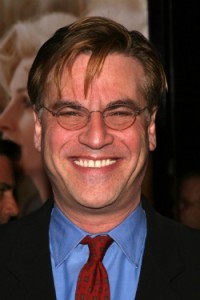
2. The Sorkin picture
The second movie has been discussed since the release of Walter Isaacson’s biography, only three weeks after Steve’s passing. Sony Pictures lost no time in buying the rights of the book with the intention to make a movie. In late November, rumors started to appear regarding the lead role: would it be Noah Wyle, who played Steve in Pirates of Silicon Valley (my personal choice), or George Clooney of Nespresso fame? Then on November 22, E!Online broke the news that Aaron Sorkin had been pitched the script, and was seriously considering it. His involvement was later confirmed.
Sorkin has a history with Steve Jobs because he was asked by Steve Jobs himself to write a screenplay for a Pixar feature. He declined that offer, unfortunately — perhaps that would have saved us from Cars 2. But I am digressing.
Sorkin is the brilliant writer behind the script of The Social Network, which tells the story of Mark Zuckerberg and his building of Facebook. I am very fond of that movie, which made the masses (re-)discover the meaning of tech entrepreneurship, in a compelling though dramatized fashion. That the same man (and same studio) will take over the adaption of Isaacson’s bio is encouraging.
However, Sorkin tried to downplay my and many others’s enthusiasm at the All Things D conference where he was speaking last week:
On his turn on stage, Aaron Sorkin talks about his concerns that he’s entering “a minefield of disappointment” as he undertakes the task of writing the movie adaptation of Walter Issacson’s Steve Jobs bio. It’s like writing about the Beatles—there’s a huge contingent of people who are emotionally attached. The screenwriter admits that he still doesn’t have a handle on Jobs—whether he should be, like most Sorkin characters, an aspirational hero or, like the fictionalized Mark Zuckerberg in the Social Network, somewhat of an antihero. (Wired)
That’s the mystery of Steve Jobs. He is both an antihero and a hero. I’m not saying this is an easy paradox to depict on screen. Will Sorkin be able to write a masterpiece out of the 700-page long press article that was the Isaacson bio? That we will see.
As for myself, I have been thinking that Steve Jobs’s life would make an amazing movie to make for several years — perhaps since 2007. Having closely studied Steve’s life for so long, I am convinced that his unique personality and the remarkable turn of events of his life would make for outstanding movie material. However, I’ve always thought to myself that not one, but at least three, if not four movies would be necessary to appropriately depict his tumultuous life. They could be titled the same as the three-part eulogy that BusinessWeek published after Steve’s passing: I. The Beginning II. The Wilderness & III. The Return.
Steve Jobs passed away today
I just woke up to the news of Steve Jobs’ death. I live in France and the news became public while I was sleeping.
The irony is that one of the last things I said before going to bed was to my girlfriend, with whom I shared my concern of the total absence of any reference to Steve during Apple’s latest event. I talked to her about Scoble’s post on Google+:
I’m hearing that Steve Jobs won’t be at tomorrow’s press event. He’s just not feeling well enough to come out in public, I hear (and yes, that makes me sad, the industry will really miss him and they will see again tomorrow why). I keep wishing that these continued rumors are wrong, but know in my head that they probably are right.
and said, “you know, maybe he’s at the hospital or something. One day we might hear he’s dead just like that, out of the blue”. Of course I never expected that day would be today, the day following the event.
It really is Steve-ian to have stayed CEO until the last possible moment. Of course the words of Steve’s resignation keep coming back into my head.
I have always said if there ever came a day when I could no longer meet my duties and expectations as Apple’s CEO, I would be the first to let you know. Unfortunately, that day has come.
But like many others I wouldn’t believe they meant his health condition had been decreasing. I thought he wanted some rest for the last years, if not months, of his life. I thought he would be there around the time his biography came out. I thought he would take time to have his house finally built. But no. Like so many geniuses and heroes before him, he fought until the last moment, and Death has come to him sooner than it should.
Of course I am still overwhelmed by the news and all the testimonials that are pouring out everywhere. I will take some time to reflect and think about what this news for Apple, even for me. As far as the website is concerned, I was working on the next version that would come out in 2-3 weeks. With today’s news I will transform the project into an online tribute to our greatest hero, the man who has changed the world several times over, one of the greatest innovators and entrepreneurs in history: our Steve.
Gems from the noise following Steve Jobs’ resignation
I’ve been working on this post for a while but I have been overwhelmed by a number of things recently so sorry about the delay.
I’ve always thought that the only positive thing that would result from Steve Jobs’ withdrawal from the public spotlight would be the flurry of stories to pour out from all corners of the Wold Wide Web. His recent resignation proved me right. To save you time and effort, here is my personal selection among the several dozens of articles and stories I have read in the past three weeks. If you think a worthy one is missing, do not hesitate to mention it in the comments.
The big news
- Steve Jobs’ resignation letter this one will go down in history
- Tim Cook’s internal letter to all Apple employees leaked to Ars Technica
Homages
- Walt Mossberg: Essay: Jobs’s Departure as CEO of Apple Is the End of an Extraordinary Era Walt Mossberg comes back on Steve Jobs’ career (disclaimer: no emotional or particularly insightful comments)
- David Pogue: Steve Jobs Reshaped Industries nice article
- Steve: Who’s Going to Protect Us From Cheap and Mediocre Now? by former Apple France boss Jean-Louis Gassée, including a perspicacious metaphor about Steve riding the animal inside him
- Michael Moritz: Jobs founded Apple not once but twice Michael Moritz wrote The Little Kingdom, the first book about Apple — in addition to the infamous TIME portrait The Updated Book of Jobs. He later went on to fund Google and became a millionaire.
- Om Malik (GigaOm): Steve Jobs and the sound of silence a poignant hommage by Om
- No, Apple Won’t Be the Same Without Steve Jobs Mike Elgan over at Cult of Mac pretty much sums up my opinion on the post-Jobs Apple, including a personal favorite:
The trouble with dictatorship or absolute monarchy is that success or failure depend entirely upon the quality of the despot. That’s why they fail. And that’s why a democracy that limits the power of leaders is best — it still works, more or less, even when incompetent morons are in power.
But what about when the dictator is literally the single best person to lead? In those almost non-existently rare instances, despotism is by far the best form of government. Heaven, for example, is not a democracy. - Apple Employees React to Steve Jobs’s Resignation (The Daily Beast)
- Where Some Earn Enmity, Jobs Won Affection (New York Times) about Steve’s uniqueness
- The NY Times has a very nice page with most of Steve Jobs patents – possible source of inspiration for the next version of all about Steve Jobs.com
- YouTube tribute: “We are all Steve”
- Adweek released an edited version of the Think Different ad with Steve Jobs in his right place at the end (the shot is from the 1981 video before he goes on TV for the first time)
Steve Jobs stories
- The Wall Street Journal’s compilation of Steve Jobs quotes good selection
- The First Time I Met Steve Jobs… Fast Company has a very nice compilation of a number of Steve Jobs stories that have come out after the resignation
- Icon Ambulance Vic Gundotra, former Microsoftee and current VP of Social at Google, tells the story of a call from Steve Jobs on a Sunday morning
- Steve Jobs’ Two-Minute Lesson by Forbes editor Quentin Hardy
- An Inspiring Story About a Young Apple Fan’s Experience With Steve Jobs an encounter at the NY 5th Avenue Store opening
- My one question for Steve Jobs in 2000 recollection from a former Apple intern
- So, Steve Jobs has left his role as Apple’s CEO nice anecdote of an encounter on Apple’s campus by former employee David Cairns
- Apple all-star alumni recall Steve Jobs’ lessons on SFGate
- You’re the ones internal Apple employee meeting
- An encounter at a restaurant by Ryan at Gdgt
Rediscovered treasures
- Joe Nocera at the NY Times gives away (PDF) a great profile on Steve Jobs he wrote back in 1986 (during the early NeXT days) for Esquire
- How Apple works: Inside the world’s biggest startup the Fortune article is finally released. Apparently author Adam Lashinsky will turn it into a book later next year
- David Pogue dug out an old article of his from 1998
- The old story (related in Alan Deutschman’s The Second Coming) on the joke played by Steve and Larry Ellison on a naive guy who thought he could run Apple, back in 1998
On Steve’s health
- Steve Jobs: ‘Unfortunately, That Day Has Come’ BusinessWeek reports Steve spent a full day at the Apple campus before he tendered his resignation, including an ’emotional’ meeting with his executive team
- Rarity of Steve Jobs’ cancer and treatment provides few predictions, few options The San Jose Mercury News confirms that no media/doctor, unless directly involved, know and can predict anything about Steve’s condition
- Jobs Struggled With Health Problems for Years The Wall Street Journal comes back on a decade of fight
- My Neighbor, Steve Jobs a touching story from a Palo Alto resident
Today is the historic day we knew would come: Steve Jobs just resigned from Apple.
So many signs were given to prepare us to that historic piece of news: not only did Steve take an unlimited medical leave of absence, he started planning a new home, and cooperated on his first authorized biography… So it would be foolish to pretend we didn’t see Steve’s resignation coming. Yet I’m sure it still resonates as a shock many of us. It certainly does to me.
Here is the letter most of you will have already read I’m sure.
August 24, 2011 06:34 PM Eastern Daylight Time
Letter from Steve JobsCUPERTINO, Calif.–(BUSINESS WIRE)–To the Apple Board of Directors and the Apple Community:
I have always said if there ever came a day when I could no longer meet my duties and expectations as Apple’s CEO, I would be the first to let you know. Unfortunately, that day has come.
I hereby resign as CEO of Apple. I would like to serve, if the Board sees fit, as Chairman of the Board, director and Apple employee.
As far as my successor goes, I strongly recommend that we execute our succession plan and name Tim Cook as CEO of Apple.
I believe Apple’s brightest and most innovative days are ahead of it. And I look forward to watching and contributing to its success in a new role.
I have made some of the best friends of my life at Apple, and I thank you all for the many years of being able to work alongside you.
Steve
I will give myself some time to think more deeply about the future of Apple and of course, of Steve himself. What I am dreading the most is the noise that we, “the Apple Community” — and especially we, Steve Jobs admirers — will have to endure in the coming months from ignorant analysts or sensationalist hacks about that historic event. I hope they will show Steve the respect he deserves.
Good luck to Tim Cook for running what is, has always been, and probably always will be, Steve’s company — and certainly his greatest masterwork.
Thank you Steve for the incredible journey you have led Apple and all of us on. I’m sure it is not over. After all, today is the first day of the rest of your life.
About blogs, biographies and apricot orchards
I have been thinking about the next version of the website for some time, and it’s time for Phase I to roll out.
I have moved the website to a new host last week. It should now be faster and more reliable. And today, I moved the blog to that same host. It is now really 100% under all about Steve Jobs.com, since all things Steve Jobs doesn’t seem to be catching on, and is just too confusing. Even though I am keeping the URL allthingsstevejobs.com, it will now point to localhost:8888/sqltest/blog. You might have noticed the better cosmetic integration with the rest of the website too.
I don’t think any of you has missed the two big pieces of Steve Jobs news from the past two weeks:
- the city of Cupertino has published the plans for the upcoming Apple ‘spaceship’ campus. It’s not bigger than the Pentagon — but close. If you’ve had a thorough look at the plans, Steve’s favored apricot orchards are showing up in the north east garden of the campus (see picture below).
- the biggest news is of course the release date of the Isaacson biography (the authorized one, not that fake Chinese one) which has been advanced to November 21. That’s right, it’s just three months away! Get the whole story from Philip Elmer-Dewitt at Fortune 2.0.
July 2011 Steve Jobs news roundup
23 Jul 2011 | in Management, Steve Jobs history, Steve Jobs news, Steve Jobs personality, Steve Jobs trivia
Busy month for me, hopefully Steve Jobs news have been somewhat slow too (apart from last week’s).
Here’s what I put aside for you:
- July 9: A weird video surfaces from Taiwan. A tea brand shamelessly used an actor to play Steve Jobs and sell bottled tea in a TV commercial. See for yourself:

(via Cult of Mac)
- July 8: French magazine Le Point reveals that Steve almost purchased a castle in the South-East of France. Pictured below, the property is valued at around €25m ($36m). Apparently Steve’s wife, Laurene, toured the property herself.

The article also relates that back in 1985, Jean-Jacques Servan-Schreiber, a French journalist close to President Francois Mitterrand, apparently asked of the head of state a special present to Steve Jobs for his 30th birthday. I’ve read many stories about that famed birthday, where tons of celebrities attended, including Ella Fitzgerald who was the party singer. Anyway, JJSS (as he is often called) reportedly suggested that the French nationality was offered to the Apple co-founder as a special gift. The French President nonchalantly refused. I think Steve would have appreciated the gift, as he has often testified of his love of France (I have made a compilation of the many times he uses France in Apple demos).
- July 11: a new Tshirt made it to the Apple Gift shop in Cupertino… making fun of the company’s cult of secrecy. I’m buying it next time I go there! (via Macrumors).
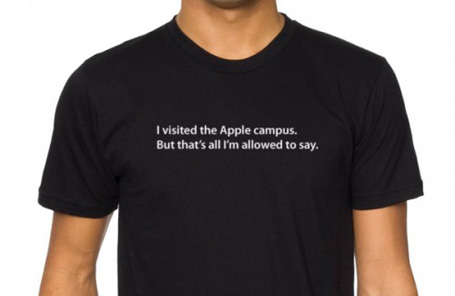
- July 21: John Gruber of Daring Fireball spotted a nice anecdote about Steve and his legendary curtesy. I am quoting the same thing he did:
The story goes that ESPN president George Bodenheimer attended the first Disney board meeting in Orlando, Florida, just after the company had bought Pixar, the innovative animation factory, and spotted Apple CEO Steve Jobs in a hallway. It seemed like a good time to introduce himself. “I am George Bodenheimer,” he said to Jobs. “I run ESPN.” Jobs just looked at him and said nothing other than “Your phone is the dumbest fucking idea I have ever heard,” then turned and walked away.
- July 21: Philip Elmer-Dewitt dug out a nice chart that compiles all the public data about Apple’s reiumbursements of the expenses of Steve’s famed private jet airplane. I think it is worth mentioning that Steve can use the jet for his personal use, but then of course the company doesn’t reiumburse him of the cost of operating it. The chart is below:
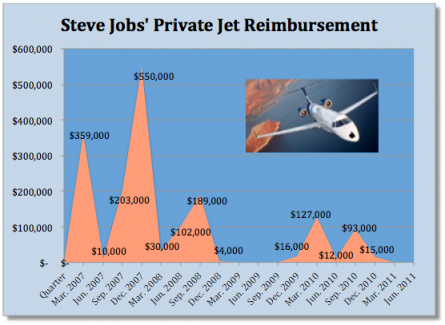
- July 23: after all the nonsense we’ve come to read about Steve’s succession lately (which did grant us a new Steve Jobs quote: “it’s hogwash”, courtesy of the Wall Street Journal) — John Gruber wrote a very good article, the kind that only he knows how to write, on the topic: On Succeeding Steve Jobs. His conclusion: “the obvious structure for a post-Jobs Apple is simply Apple as we know it, without Steve Jobs.” I believe he is 100% right and that’s what we will see, perhaps as early as next year. BUT, and it’s a big BUT, I am not sure Tim Cook can keep the fire alive as Steve did for the next decade. And as I’ve stated before, I think he will have trouble running the company unchallenged the way only the genius-founder Steve Jobs can. His authority to run the super-disciplined fruit company will probably be challenged a couple of years after Steve is gone… Time will tell.
